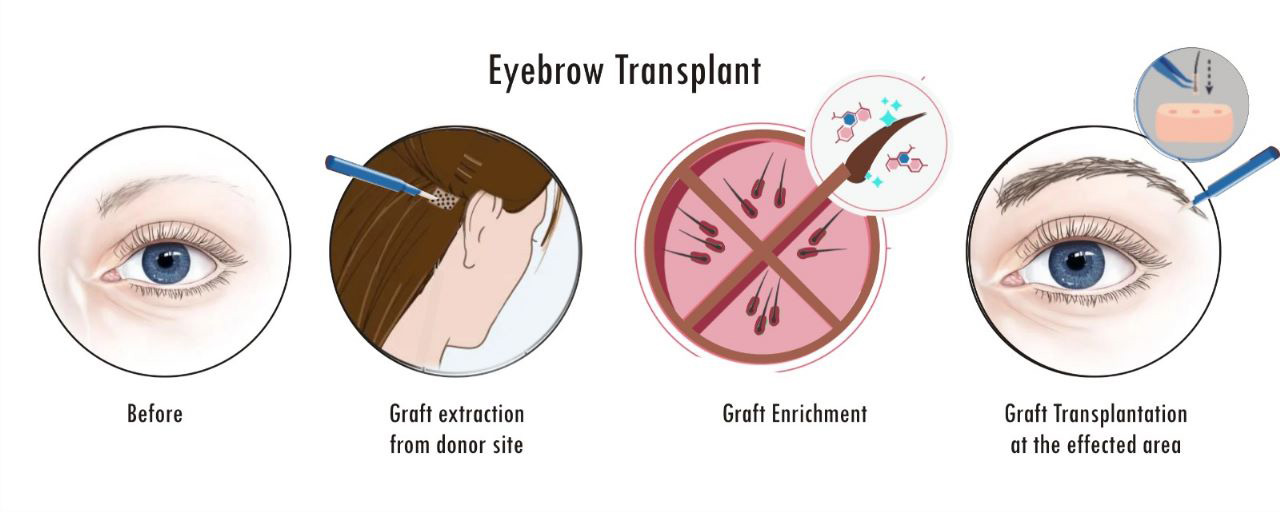Eyebrow Transplant

Eyebrow transplant is a revolutionary treatment that allays the worries of those who have lost their eyebrows for a variety of reasons. Using the cutting-edge FUE procedure, Livglam Hair Transplant Clinic in Bangalore provides remarkable remedies for sparse eyebrows or those caused by medical issues.
What are Eyebrow Transplants?
Eyebrow hair transplants provide a specialized method for generating thicker and fuller brows by carefully implanting healthy hair roots into the recipient area after being carefully transferred from safe donor sites, such as the occipital or parietal regions of the head. This ground-breaking operation, carried out at the Livglam Hair Transplant Clinic in Bangalore, makes use of cutting-edge methods like FUT or FUE to guarantee maximum graft survival and outcomes that seem natural.
Eyebrow Implants at Livglam Hair Transplant Clinic, led by the esteemed Dr. Harish and her accomplished team, offer a remarkable solution for individuals seeking thicker and fuller eyebrows.
Procedure of Eyebrow Transplant in Bangalore:
At Livglam, the eyebrow hair transplant procedure follows a similar approach to traditional hair transplants, ensuring natural and long-lasting results. Our expert surgeons take hair grafts from the donor area above your ears during the procedure. These grafts contain not only individual hairs but also hair follicles, encouraging the development of new eyebrow hairs when the original transplanted ones fall off.
Our skilled surgeon carefully makes small incisions at the donor sites and the transplantation sites within your brows while using a general anesthesia. This meticulous procedure usually takes 2 to 3 hours to perform, guaranteeing attention to detail and the best outcomes.
What precautions should be taken post the eyebrow hair transplant?
The natural appearance created as a result of the transplanted hairs originating from your own body is emphasized by supporters of eyebrow hair transplants. This makes sure that the new eyebrows match your hair colour perfectly. Along with providing a natural appearance, the process may lessen the need for brow cosmetics, enabling you to have naturally thicker, better-defined brows.
Although eyebrow transplants have shown positive results, it's crucial to take into account the possibility that the newly implanted hair follicles won't establish themselves. In such cases, it could be necessary to do a supplementary process in the future to get the desired result. To reduce these dangers and guarantee the best outcomes for your brow transplant, it is essential to consult with a qualified and experienced surgeon like Dr. Harish at Livglam.
Who is eligible for an eyebrow transplant procedure?
For those who want bigger eyebrows, have fading brow tattoos, or have lost eyebrow hair, eyebrow transplantation is a common option. It provides a long-lasting fix, doing away with the requirement for everyday brow makeup application. People who have alopecia areata or trichotillomania, as well as those who have had skin-related wounds like burns or scars, may choose to have their eyebrows transplanted. Although the procedure is commonly chosen by women and individuals assigned female at birth, men and individuals assigned male at birth also seek this cosmetic surgery.
Difference between eyebrow transplant and microblading
Although both eyebrow transplant and microblading are cosmetic operations to increase eyebrow fullness, their methods and times are different:
Microblading: A cosmetic tattoo technique that uses a hand-held device and small needles. lasts a few years before needing maintenance.
Eyebrow Transplant: Surgical procedure transferring hair follicles from the scalp to eyebrows. Provides a long-term or permanent solution for fuller eyebrows.

An eyebrow transplant is a surgical process with a more long-lasting result than microblading, which is non-invasive and temporary. Preferences and desired longevity influence the choice.
| Eyebrow Transplant | Microblading |
|---|---|
| Eyebrow Implants take up to 6 hours to completion | Microblading procedure takes up to 2 hours |
| Authentic placement of new hair strands | It is a quick fix for semi-permanent fill-ins. |
| Final result may take 6 months up to one year | Results are instantly seen after the procedure |
| More expensive procedure | Affordable cost |
| Permanent solution | Need yearly touch-ups to maintain results |
Frequently Asked Questions
The transplanted hairs usually fall out within the first several weeks after an eyebrow transplant. Within a few months, new hair will start to grow, but it may take between nine and twelve months to get the complete effects.
The operation for regrowing eyebrows is frequently carried out under local anesthesia, which helps to reduce discomfort. Some patients may suffer some discomfort or soreness following surgery, but this may be handled with painkillers that the medical professional will prescribe.
After an eyebrow transplant, healing times can differ from person to person. Within a few days to a week of the treatment, the majority of patients can return to their regular activities. To promote adequate healing and the best outcomes, it's crucial to adhere to your surgeon's post-operative care guidelines.
Yes, a transplanted brow usually has long-lasting effects. The hair follicles that have been transplanted are typically resistant to the effects of hair loss, resulting in long-lasting and realistic-looking results. But it's crucial to remember that over time, the natural ageing process may still have an impact on how the eyebrows look.
There are certain potential dangers and consequences with eyebrow transplants, just like with any surgical operation. These include things like an infection, scars, asymmetry, and poor hair development. The outcome of the treatment can be improved by selecting a qualified and experienced surgeon, according to post-operative care instructions, and scheduling regular follow-up appointments.
Procedure Time:
- 2-3 Hours
Full Recovery:
- 4-5 Days
Anesthetic:
• Local
Results:
• 2 to 3 Months
Back to work:
• After 3 days
Risks:
• Infection, Bleeding
* Individual results and reactions may vary.
